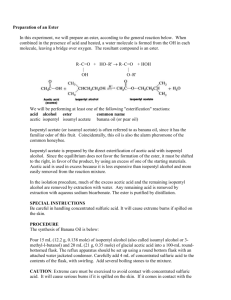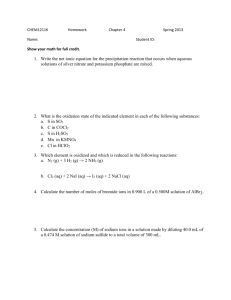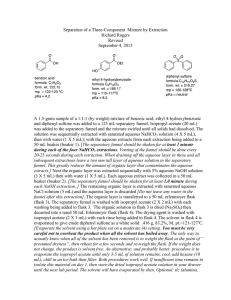SYNTHESIS ISOPENTYL ACETATE
advertisement
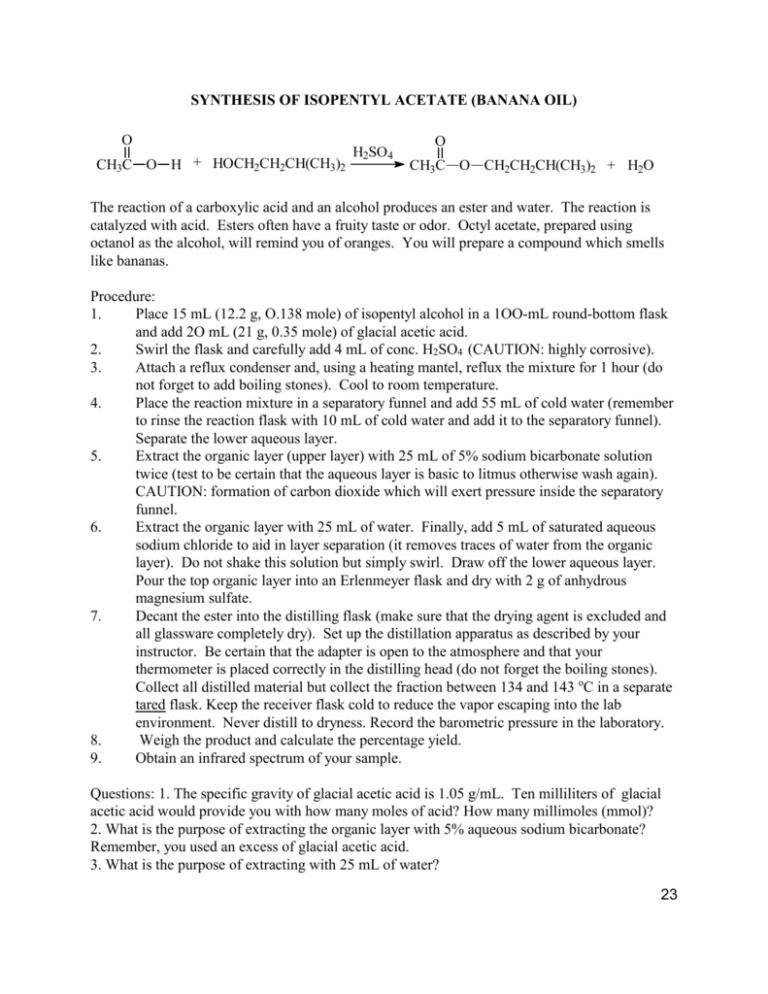
SYNTHESIS OF ISOPENTYL ACETATE (BANANA OIL) O CH3C O H + HOCH2CH2CH(CH3)2 H2SO4 O CH3C O CH2CH2CH(CH3)2 + H2O The reaction of a carboxylic acid and an alcohol produces an ester and water. The reaction is catalyzed with acid. Esters often have a fruity taste or odor. Octyl acetate, prepared using octanol as the alcohol, will remind you of oranges. You will prepare a compound which smells like bananas. Procedure: 1. Place 15 mL (12.2 g, O.138 mole) of isopentyl alcohol in a 1OO-mL round-bottom flask and add 2O mL (21 g, 0.35 mole) of glacial acetic acid. 2. Swirl the flask and carefully add 4 mL of conc. H2SO4 (CAUTION: highly corrosive). 3. Attach a reflux condenser and, using a heating mantel, reflux the mixture for 1 hour (do not forget to add boiling stones). Cool to room temperature. 4. Place the reaction mixture in a separatory funnel and add 55 mL of cold water (remember to rinse the reaction flask with 10 mL of cold water and add it to the separatory funnel). Separate the lower aqueous layer. 5. Extract the organic layer (upper layer) with 25 mL of 5% sodium bicarbonate solution twice (test to be certain that the aqueous layer is basic to litmus otherwise wash again). CAUTION: formation of carbon dioxide which will exert pressure inside the separatory funnel. 6. Extract the organic layer with 25 mL of water. Finally, add 5 mL of saturated aqueous sodium chloride to aid in layer separation (it removes traces of water from the organic layer). Do not shake this solution but simply swirl. Draw off the lower aqueous layer. Pour the top organic layer into an Erlenmeyer flask and dry with 2 g of anhydrous magnesium sulfate. 7. Decant the ester into the distilling flask (make sure that the drying agent is excluded and all glassware completely dry). Set up the distillation apparatus as described by your instructor. Be certain that the adapter is open to the atmosphere and that your thermometer is placed correctly in the distilling head (do not forget the boiling stones). Collect all distilled material but collect the fraction between 134 and 143 oC in a separate tared flask. Keep the receiver flask cold to reduce the vapor escaping into the lab environment. Never distill to dryness. Record the barometric pressure in the laboratory. 8. Weigh the product and calculate the percentage yield. 9. Obtain an infrared spectrum of your sample. Questions: 1. The specific gravity of glacial acetic acid is 1.05 g/mL. Ten milliliters of glacial acetic acid would provide you with how many moles of acid? How many millimoles (mmol)? 2. What is the purpose of extracting the organic layer with 5% aqueous sodium bicarbonate? Remember, you used an excess of glacial acetic acid. 3. What is the purpose of extracting with 25 mL of water? 23 4. Why is it necessary to record the barometric pressure when distilling at atmospheric pressure? 5. The size of the distilling apparatus affects the amount of material that cannot be distilled (the holdup). Assume that you could have used a distilling flask with a volume of 0.05 L or one with a volume of 0.10 L. Using the ideal gas law, PV=NRT, calculate the number of moles of vapor remaining in the flask at 127oC at 1 atm pressure for both cases. 6. Can you name another ester you synthesized this semester? What was the “alcohol” used? 24
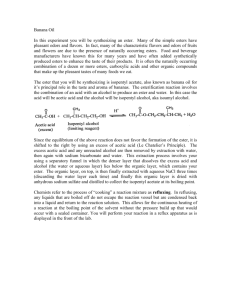

![Isopentyl Acetate [Banana Oil] In this experiment, we prepare an](http://s3.studylib.net/store/data/008730431_1-27d60b2e4c34d7ce18e86c4d6c41e860-300x300.png)
